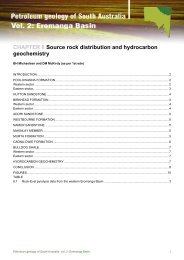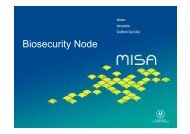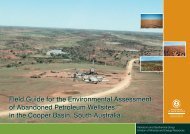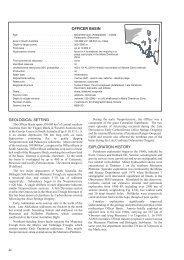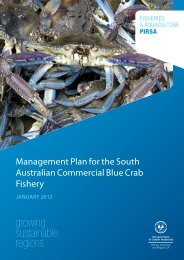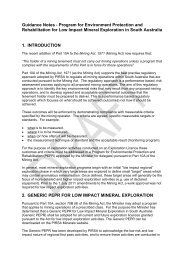Chapter 2: History of petroleum exploration and development - PIRSA
Chapter 2: History of petroleum exploration and development - PIRSA
Chapter 2: History of petroleum exploration and development - PIRSA
Create successful ePaper yourself
Turn your PDF publications into a flip-book with our unique Google optimized e-Paper software.
Petroleum geology <strong>of</strong> South Australia. Vol. 4: Cooper Basin.THE MODERN DECADEThe licence area <strong>and</strong> the ProducersIn 1979 the <strong>exploration</strong> rights granted to Delhi–Santoshad been modified when the companies volunteered to halvethe area covered by PELs 5 <strong>and</strong> 6 to 284 086 km 2 . The areacovered was then divided into the Cooper, Pedirka <strong>and</strong>Arrowie Sectors. The Cooper Sector is not subject to anyrelinquishment provisions until February 1999 when the<strong>exploration</strong> rights to the whole Cooper Basin expire withoutthe right <strong>of</strong> renewal. The Pedirka <strong>and</strong> Arrowie Sectors weresubject to relinquishment <strong>of</strong> 25% at five-year intervalscommencing in February 1984. Under the 1984 conditions<strong>of</strong> renewal the area <strong>of</strong> PELs 5 <strong>and</strong> 6 was reduced to231 948 km 2 <strong>and</strong> Delhi–Santos were required to drill 54wells <strong>and</strong> acquire 4000 km <strong>of</strong> seismic in the Cooper Sector.In subsequent years additional voluntary minorrelinquishments were made until February 1989 when thearea <strong>of</strong> PELs 5 <strong>and</strong> 6 was halved again (to 111 756 km 2 ).Within a year the area was again reduced (to 73 202 km 2 ) <strong>and</strong>minor reductions to the <strong>exploration</strong> zone in the PEL areahave followed: the area <strong>of</strong> a PPL is excised from the<strong>exploration</strong> licence when a PPL is issued.The Brown Liberal Government (1993–96) confirmed in1995 that no rights <strong>of</strong> renewal would apply to existingCooper Basin <strong>exploration</strong> tenements on their expiry in 1999.This policy was intended to facilitate active upstreamindustry competition in gas <strong>exploration</strong> <strong>and</strong> supply as bidswould be sought for new tenements from the industry atlarge. The more than 80 PPLs then existing over about3500 km 2 were not to be affected by the expiry <strong>of</strong> PELs 5<strong>and</strong> 6. But in September 1997 Premier J. Olsen (1996–)announced that the Liberal Government agreed to allowSantos to retain tenure over the Nappamerri Trough until atleast 2013. In accord with their rights under the RatificationAct, in November 1997 Santos <strong>and</strong> its partners were issuedwith 17 PPLs over the Nappamerri Trough (Fig. 2.6). Thelicences cover an area <strong>of</strong> about 4100 km 2 <strong>and</strong> contain apotentially large resource <strong>of</strong> gas in very low permeabilityreservoirs. The company will have to spend more than$100 million over 15 years to retain all <strong>of</strong> this area until2013. Partial acreage relinquishment will apply at the end <strong>of</strong>five <strong>and</strong> ten years <strong>and</strong> relinquishment requirements willapply in 2013 to any areas where commercial production hasnot been established.As operator Santos is now responsible for 13 jointventures, the Cooper Basin Producers Unit <strong>and</strong> theDownstream (for the transport, processing <strong>and</strong> storage <strong>of</strong>liquids at Port Bonython) Agreement in South Australia.Until late 1996 each share (a participation factor) in theProducers Unit reflected the net quantity <strong>of</strong> gas, ethane,condensate <strong>and</strong> so on <strong>and</strong> the quantity <strong>of</strong> reservescontributed by that company (Fig. 2.7). The reserves wererecalculated biannually <strong>and</strong> the participation factor changedin response to new discoveries <strong>and</strong> adjustments to reserves’estimates, among other things. The complex arrangementhad led to court proceedings more than once. After twodecades the review <strong>and</strong> adjustment method <strong>of</strong> establishing acompany’s share was discarded. The arrangement wassimplified by instituting a fixed participation factor for both<strong>exploration</strong> <strong>and</strong> production interests <strong>and</strong> for all <strong>petroleum</strong>products within PELs 5 <strong>and</strong> 6 (the exception being theGoal attainment scaling applied to the environmental assessment<strong>of</strong> ab<strong>and</strong>oned <strong>petroleum</strong> wellsites. (top) -2 score (much less thanexpected outcome): the track is prominent because <strong>of</strong> a scrapedsurface, windrows along its edges or gully erosion. (bottom) +2score (much more than expected outcome): the track contours <strong>and</strong>colour blend with the surroundings <strong>and</strong> the earthwork disturbanceis indistinguishable. (Photos 45045, 45049)Patchawarra East Block, which retained its existinginterests). Fixed participation factors were also applied tothe Downstream Agreement. The change has reduced boththe time <strong>and</strong> cost involved in the review process <strong>and</strong> thepotential for litigation.In regards to the agreement to supply Cooper Basin gasto AGL (Fig. 2.8), in 1995 the Australian Competition <strong>and</strong>Consumer Commission (ACCC) initiated a review <strong>of</strong> its1986 authorisation <strong>of</strong> the agreement. Although theagreement is shielded from the provisions <strong>of</strong> the TradePractices Act by the Ratification Act, authorisation had beengiven previously to enable holding any gas price arbitrationunder the agreement in New South Wales instead <strong>of</strong> SouthAustralia. In 1996 the ACCC determined that theAgreement contained three anti-competitive clauses(providing for first right <strong>of</strong> refusal, take-or-pay <strong>and</strong>exclusive dealings). Accordingly the authorisation waswithdrawn excepting for a time-limited authorisation <strong>of</strong> agas price establishment clause. In 1997 the Producers wontheir appeal to the Australian Competition Tribunal againstthe determination (PESA News, 1998).RoyaltiesIn the late 1980s the State Government had taken theview that South Australia should not receive less royalties32










